 |
Feast Days of Our Lady
Our Lady of Almudena, November 9
Prof. Plinio Corrêa de Oliveira
Biographical selection:
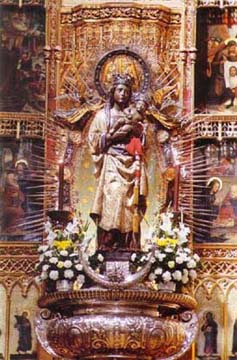
Our Lady in the Almudena Cathedral |
The devotion to Our Lady of Almudena, patroness of Madrid, began in the 11th century. Tradition tells us that when Dom Alfonso VI conquered Madrid in 1083, he immediately ordered the purification of the Church of Santa Maria, which had been profaned by the Moors.
Since the statue of Our Lady, which the Apostle St. James had placed in that building in the early days of the Chuch, had disappeared, the King, together with the religious authorities, made a procession praying to Our Lord to help them find the statue. The pious cortege processed around the walls of the city, singing and praying.
At a certain moment, part of the wall fell and they found the statue of Our Lady that had been hidden there for over 300 years. On either side of the statue were two candles – still lighted and burning – that Catholics had placed there in homage of the Virgin before closing the niche where they had hidden her statue. Almudena means market or granary, and this name was given to the statue because the place where it was hidden was near the Moorish granary.
Comments of Prof. Plinio:
This incident from History is most beautiful. In its beauty are two remarkable points.
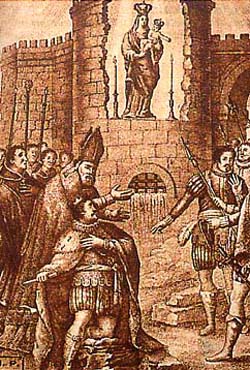
The wall falls and the statue is discovered between the two lighted candles |
First, it is beautiful to see how Our Lady rewarded the faith of those warriors, those Crusaders, who did not find the statue but immediately made a procession – convinced that they would recover it because they were certain of the value of their prayers. Then, they found it and named it, giving it the title Nuestra Señora de Almudena because it had been hidden next to the granary of the Moors, in this way repairing the profanation the Muslims had made.
Second, it is beautiful to note how Our Lady also rewarded the faith of those who had hidden her statue. They were Visigoth Catholics around the years 712-714 who saw that the Moors would conquer the city and were unable to carry the statue away with them. So they closed up the statue in that niche inside the walls of the city so that it would not be profaned by the Mohammedans.
It is interesting to observe that they lit two candles in homage of Our Lady before they closed up the niche. One can easily see that they confided that the statue of Our Lady would one day again be venerated. They made the small niche like a small chapel and lighted the candles. To justify their confidence, a miracle was worked. For more than 300 years those lamps burned continuously inside the city wall. When the wall fell, they were still there burning. In my opinion, it is a miracle as magnificent as the multiplication of loaves and fishes reported in the Gospel. It is a truly marvelous thing!
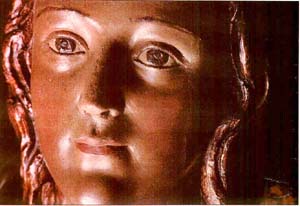
Close-up of the statue, patroness of Madrid |
This is to signify that even when the causes of Our Lady appear smashed and defeated, there is always something irreversibly victorious in them. Those burning lamps are the lamps of the confidence of the faithful Catholics. Where confidence exists, there is the possibility of a resurrection, a restoration, a victory. Even in the most hostile situations, Our Lady works miracles. For the one who confides, nothing is impossible.
This is very important to our spiritual life. Nothing is impossible if we confide against all hope. Even when the greatest reasons for discouragement surround us, we must confide. Our Lady will reward us. The confidence that never weakens, that always maintains its flame alive, is never forgotten by Our Lady. When the hour comes, she will reward that confidence with extraordinary graces.
This confidence also applies to the cause of the Counter-Revolution. The Scripture affirms: Residuum revertetur (the remnant will return). It is a promise to those who have been defeated and smashed by the enemies of the cause of God. The continuity of those who are faithful to God will be maintained. This should serve to stimulate in our souls the confidence to continue to burn, like the two lamps of Our Lady, with the conviction of the irreversibility of the Kingdom of the Immaculate Heart of Mary. It will come, as Our Lady predicted in Fatima.

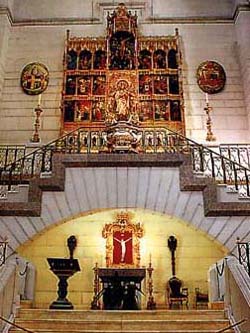
Five days before the consecration of Almudena Cathedral, completed in 1993 (below), Our Lady of Almudena was moved from San Isidro church to a side altar there where it is venerated today (above).
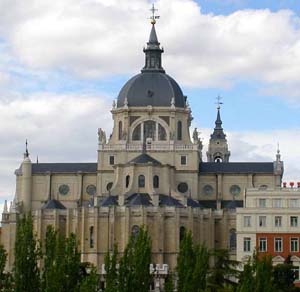 |

  | | Prof. Plinio Corrêa de Oliveira | |
The Saint of the Day features highlights from the lives of saints based on comments made by the late Prof. Plinio Corrêa de Oliveira. Following the example of St. John Bosco who used to make similar talks for the boys of his College, each evening it was Prof. Plinio’s custom to make a short commentary on the lives of the next day’s saint in a meeting for youth in order to encourage them in the practice of virtue and love for the Catholic Church. TIA thought that its readers could profit from these valuable commentaries.
The texts of both the biographical data and the comments come from personal notes taken by Atila S. Guimarães from 1964 to 1995. Given the fact that the source is a personal notebook, it is possible that at times the biographic notes transcribed here will not rigorously follow the original text read by Prof. Plinio. The commentaries have also been adapted and translated for TIA’s site.
|
Saint of the Day | Home | Books | CDs | Search | Contact Us | Donate

© 2002- Tradition in Action, Inc. All Rights Reserved
|
 |

|